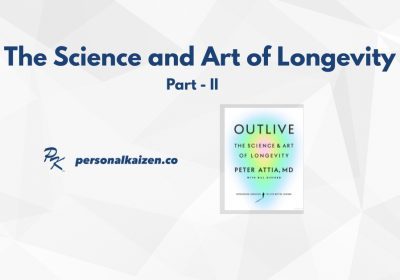
Outlive: The Science and Art of Longevity is a 2023 book by physician and podcaster Peter Attia, MD. I have regularly listened to Attia’s podcast “the drive” for the past 3-4 years and like that his guests are experts in areas of health and wellness. He wrote Outlive over many years to summarize his current thinking on longevity and aging well. Attia’s podcasts and book can get detailed and complicated; here is a simple summary of what you can do to improve.
Attia describes attending the funeral for the mom of a good friend. The 67-year-old mom had been a vibrant, athletic woman when Attia met her 15 years ago. Soon after, she slipped and fell while gardening and spent the next ten plus years of her life with severe back and neck pain that made her unable to enjoy her hobbies. She just sat around the house, depressed, and eventually descended into dementia before dying at the age of 83.
Attia notes that this is a sad but typical story of growing older today. While we may be living longer lives, the quality of life is more important to him and his patients than the length of life.
Attia differentiates between modern medicine and his goal for longevity. Healthcare today is great at treating diseases and helping you stay alive longer. Attia cares more about preventing disease and living to an old age while still being able to live a normal life. This requires:
- Doing what you can to prevent disease
- Actions that will maintain physical and mental health as you grow older
Preventing Disease
The odds today are overwhelming that you will die as a result of heart disease, cancer, neurodegenerative disease, or type 2 diabetes and related metabolic dysfunction. Attia calls these “the Four Horsemen” diseases and devotes chapters to describing each of them.

- Cardiovascular Disease encompasses conditions like heart attacks, strokes, and heart failure. Heart disease is the leading cause of death, but can be minimized.
- Cancer treatment is where much of healthcare focuses today, but we should focus on prevention and detection. You minimize your risk by eating well and not smoking. Attia also highlights the importance of various screening methods to reduce cancer risk.
- Neurodegenerative Disease includes conditions like Alzheimer’s disease and Parkinson’s disease. Attia stresses the significance of maintaining cognitive function throughout life and explores interventions like exercise, nutrition, and cognitive training to mitigate risk.
- Metabolic Dysfunction refers to conditions like type 2 diabetes and insulin resistance. Attia delves into the role of nutrition, exercise, and lifestyle in managing metabolic health and preventing the development of metabolic disorders.
Maintaining your health and wellness
Many of the strategies for preventing the four killers above are the same strategies you should focus on to improve your healthspan – your general quality of life as you grow older. The rest of this summary will focus on the key focus areas Attia identifies.
- Exercise
- Food and Nutrition
- Sleep
- Emotional Wellbeing
- Detection

If you can prevent the four horsemen of disease, you will live to an old age. Attia wants us to thrive in these older years and has a list of physical tasks you should remain able to perform as you age. Here are some of the events in his Centenarian Decathlon:
- Hike 1.5 miles on a hilly trail
- Get up off the floor using only one arm
- Pick up a young child from the floor
- Climb four flights of stairs in three minutes
- Open a jar
We should all strive to be able to do these tasks (and more) at the age of 100!
Exercise: The Most Powerful Longevity Drug
If you increase your muscle strength and improve your cardiorespiratory fitness, you will reduce your risk of dying from all causes by a far greater magnitude than you could achieve by taking any cocktail of medications. Exercise also prevents both cognitive and physical decline better than any other intervention.
Attia recommends both steady endurance exercises to improve mitochondrial efficiency and high-intensity interval training (HIIT) for improving cardiovascular health. Endurance exercise produces factors that directly target regions of the brain responsible for cognition and memory, help lower inflammation and oxidative stress, and is the only intervention shown to delay the progression of Parkinson’s.
Here is a routine I developed based on the ideas in Outlive:

- A minimum of 3 hours per week of Zone 2 exercise. Zone 2 is exercising at a pace where you can still carry on a normal conversation, but just barely. I often play basketball, but also jog, ruck (hike with a weighted vest), or bike in Zone 2.
- Once or twice per week add in a HIIT workout. Go four minutes at the maximum pace you can sustain for this amount of time – not an all-out sprint, but still a very hard effort. Then ride or jog for four minutes easy, which should be enough time for your heart rate to come back down to below about one hundred beats per minute. Repeat this four times and then cool down.
Peak aerobic cardiorespiratory fitness, measured in terms of VO2 max, is perhaps the single most powerful marker for longevity. Extremely high aerobic fitness was associated with the greatest survival. The HIIT workout will increase your VO2 Max score – a measure of how well your body uses oxygen. Increasing your VO2 max makes you functionally younger. VO2 max declines steeply with age. This decline corresponds to diminished functional capacity.
Strength Training is as Important as Exercise!

I was surprised to learn in the book that weightlifting is as important as Zone 2 and HIIT exercise. Having stronger muscles helps support and protect the body. It also maintains metabolic health, because those muscles consume energy efficiently. Your exoskeleton (muscle) keeps your actual skeleton (bones) upright and intact, so having more muscle mass protects you from all kinds of trouble.
Strength training, especially with heavy weights, also stimulates the growth of bone.
Think of strength training as akin to saving for retirement. Just as we want to retire with enough money saved up to sustain us for the rest of our lives, we want to reach older age with enough of a “reserve” of muscle (and bone density) to protect us
Include the following in your strength training routine:
- Concentric and eccentric loading for all movements: lift the weight up and put it back down, slowly and with control.
- Pulling motions, at all angles from overhead to in front of you.
- Hip-hinging movements, such as the deadlift and squat, and exercises that strengthen the legs, glutes, and lower back.
- Some kind of carrying (dumbbells, kettlebells, etc.) or hanging. Grip strength is strongly inversely associated with the incidence of dementia; the greater your grip strength, the lower your risk of dementia.
- Don’t forget the importance of stretching before a workout.
I’m designing a new weightlifting routine that I will share in a future post. My routine will cover all of the above in just one hour per week!
Summary
We really hope you will use the information in our summary of the book Outlive to improve your life and your daily habits. This post is already getting long, so we will complete our summary of the book in our next post.




